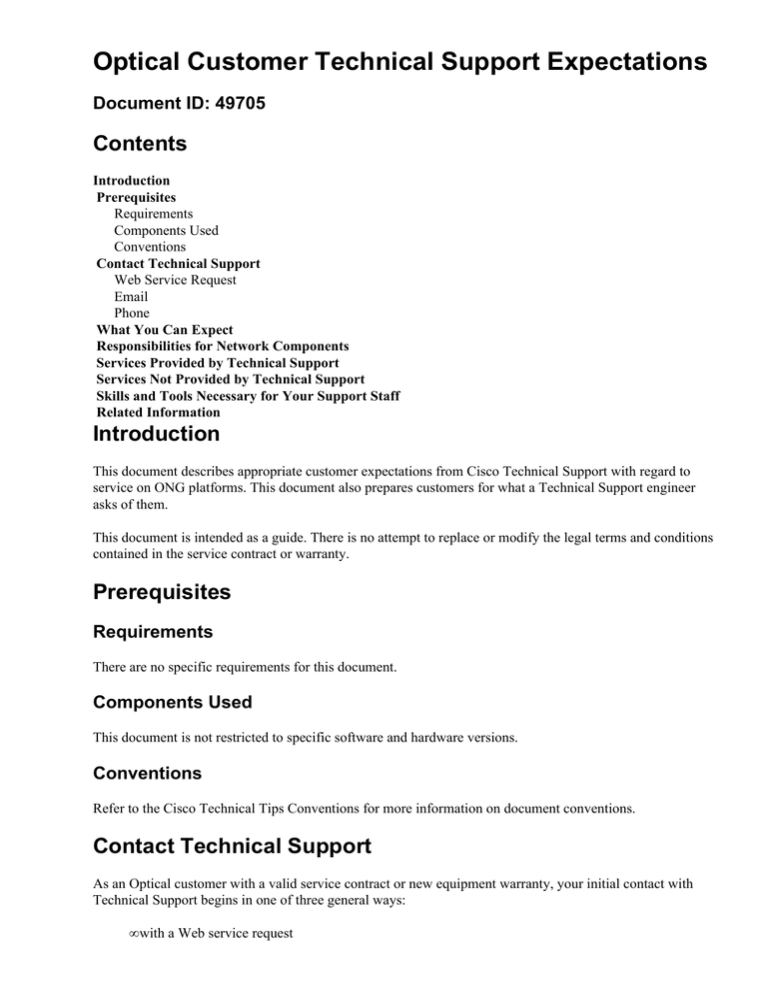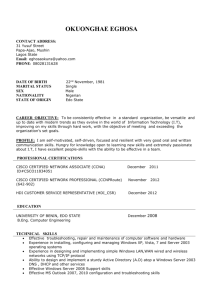
Optical Customer Technical Support Expectations
Document ID: 49705
Contents
Introduction
Prerequisites
Requirements
Components Used
Conventions
Contact Technical Support
Web Service Request
Email
Phone
What You Can Expect
Responsibilities for Network Components
Services Provided by Technical Support
Services Not Provided by Technical Support
Skills and Tools Necessary for Your Support Staff
Related Information
Introduction
This document describes appropriate customer expectations from Cisco Technical Support with regard to
service on ONG platforms. This document also prepares customers for what a Technical Support engineer
asks of them.
This document is intended as a guide. There is no attempt to replace or modify the legal terms and conditions
contained in the service contract or warranty.
Prerequisites
Requirements
There are no specific requirements for this document.
Components Used
This document is not restricted to specific software and hardware versions.
Conventions
Refer to the Cisco Technical Tips Conventions for more information on document conventions.
Contact Technical Support
As an Optical customer with a valid service contract or new equipment warranty, your initial contact with
Technical Support begins in one of three general ways:
• with a Web service request
• by email
• by phone
This guide describes each of these methods briefly. Refer to Technical Support Overview for additional
information.
Web Service Request
Cisco.com contains a great deal of helpful information about the operation and maintenance of our Optical
transport platforms. Cisco.com is a good place to start when you have a question about the performance of
your system. If you are unable to find the answer you need, open a Technical Support service request with
your web browser. This method allows you to include information such as log files or error messages, which
can provide valuable information to the Technical Support engineer assigned to your service request. When
you open your service request, you can choose whether you want a return telephone call from an engineer or
whether you prefer to receive an email response.
Email
Sometimes the most efficient method to get started is to open a service request by email. You can use email to
provide detail that is sometimes difficult to deliver by voice.
Phone
The Technical Support main phone number for access from North America is (800) 553−2447. You can
initiate a call at any time of the day or night, 365 days of the year. Refer to Customer Service Contacts to
determine the best number to use for access from other parts of the world.
After you have opened a service request, your assigned engineer might provide you with his or her direct
phone number for ease of access. Sometimes, this is a number in Europe. If you need to contact your engineer
directly and do not have access to overseas phone lines, you can always call the main Technical Support
number and ask the agent to transfer you to your engineer.
Email service requests are queued with requests that arrive by phone. Phone calls do not receive priority over
email service requests. In many circumstances, email service requests are handled before phone calls.
This is additional information to help you open a service request with Technical Support by phone:
• The contact assigned to the service request is asked to be prepared to assist with troubleshooting and
problem resolution.
• Out of respect for and in recognition of the security of your internal network, our engineers do not
dial into your system without express authorization from your central point of contact when a problem
is investigated.
• In the event the Technical Support engineer is not able to get in touch with the service request contact,
the engineer leaves a message and tries alternative methods of contact as applicable.
• The Technical Support staff makes a concerted effort to reach the contact; however, the contact's help
and availability is necessary to proceed with the service request resolution.
What You Can Expect
As a customer, you can expect:
• Your first call to the Technical Support department to be answered within three minutes.
Your first call is handled by an agent whose purpose is to locate a highly qualified Optical engineer
who can address your issue, and if needed, escalate to the proper internal channels.
Subsequent actions depends on the document priority:
♦ For Priority 1 (P1) or P2 service requests, the initial Cisco agent locates the appropriate
engineer and provides you with a live handoff. In most cases, this takes no more than 15
minutes. Outside of standard business hours, it is possible for it to take up to an hour for an
engineer to respond.
♦ For P3 or P4 service requests, you are advised to expect a return call when an engineer is
available to help. You can expect an engineer to respond within one hour for all calls received
during standard business hours. Outside of standard business hours, a Cisco engineer
responds no later than the next business day.
• The engineer who accepts your service request owns your satisfaction. You can expect the engineer to
resolve your problem or, based on priority and time constraints, hand the service request off to
another qualified engineer.
♦ Because Cisco does not use a tiered system, your first contact is with a highly qualified Cisco
engineer. This engineer reviews your problem with you and develops an effective plan for
resolution.
♦ Overall resolution time varies based on the complexity of the problem and the priority you
assign to the service request. In general, this table shows the Technical Support goals for
problem resolution:
Service Request Severity
P1
P2
P3
P4
Solution Delivery Goal
1 day
2 days
5 days
10 days
Responsibilities for Network Components
Your warranty or service contract with Cisco covers Optical transport equipment and the software operating
thereon. The supporting infrastructure belongs to you. Cisco engineers do everything possible to help you
diagnose problems with components outside of our product line, but the engineers cannot actively take charge
of third−party systems or software. This is one area where your help is essential.
Services Provided by Technical Support
In an effort to resolve your service request, the Technical Support department can:
• Diagnose and troubleshoot your problem as it pertains to Cisco Optical platforms. As previously
stated, the Technical Support department makes every effort to assist you with troubleshooting
third−party platforms, but ultimately is not responsible for them.
• Access your system by WebEx (Desktop sharing URL) or Virtual Private Network (VPN) to
troubleshoot problems.
• Confirm the configuration of your system in accordance with other network components.
• Provide necessary scripts and software to collect detailed troubleshooting information and
diagnostics.
• File defect reports with the Cisco development team when a product fails to perform as specified.
• Assist with the implementation of corrected software versions when bugs are resolved.
• Replace failed hardware (Return Materials Authorized [RMA]). Your part is replaced based on the
current service level you have on your product. These are the typical options:
♦ Standard Warranty: 15−day Return To Factory (RTF) replacementThis means that when
you experience a problem with a product which requires replacement of the affected device,
you have to ship the product back to Cisco before you receive the replacement.
♦ Advance Replace (AR) Next Business Day (NBD) replacementThis option is an
enhancement to the standard warranty and must be purchased as a contract to supplement
warranty service.
♦ On−site Service (OS) two− or four−hour onsite delivery of partThis is an enhancement to
the standard warranty and must be purchased as a contract to supplement warranty service.
• Process requests for an Engineer Failure Analysis (EFA) initiated by one of these parties on returned
parts:
♦ customer requested
♦ Technical Support engineer requested
♦ developer requested
• Technical Support service and support is primarily delivered remotely. The vast majority of
information the Technical Support engineer needs is available through this method. In addition,
troubleshooting tools and other data used to analyze specific problems are located within the
Technical Support department.
In the rare instance that all remote troubleshooting capabilities are exhausted, Technical Support can
choose to dispatch an Advanced Field Service Engineer (AFSE) to help facilitate the troubleshooting
efforts. This is at the sole discretion of the Technical Support engineer and management team. This
AFSE is a highly skilled Optical engineer. The AFSE strives to bring the appropriate test equipment
for the type of troubleshooting to be performed. This engineer does not bring any replacement
hardware. With 72 hours notice, an AFSE resource can be committed. Notice that less than 72 hours
is met with commercially reasonable efforts.
Services Not Provided by Technical Support
These services are not provided by Technical Support:
• Upgrades or support of any third−party products.
• Network designThe main focus of Technical Support is to repair operational production systems
which have failed. Network design is not a skill that Technical Support engineers practice on a routine
basis. They can help you contact your Cisco system engineer, who can assist with design or re−design
projects.
• Product upgradesThe success of any software upgrade is a direct reflection of the preparation that
goes into it. This requires a depth of familiarity with your network that Technical Support engineers
lack. The Technical Support staff responds to your calls should your upgrade process run into
problems during execution. Cisco does have an upgrade team who can provide auditing, planning, and
upgrade services for you. These services are available for a fee. They are not part of the normal
maintenance contract or warranty.
• TrainingTechnical Support engineers are more than willing to help you understand issues you have
with your Cisco product. However, there are better resources that provide basic training in product's
operation or maintenance. Cisco maintains a comprehensive list of training partners to assist in this
area.
Skills and Tools Necessary for Your Support Staff
In order to assist with the timely resolution of your problems, your support staff is able to:
• Access and effectively utilize test equipment necessary for troubleshooting complex problems (such
as SONET test sets and power meters)
• Perform basic PC commands (such as telnet, ping, tracert and be familiar with the output)
• Understand any special security limitations or restrictions that exist on the system
• Understand the complete network topology (LAN or SONET) and be able to provide this information
in electronic format.
• Login to a Cisco.com account to access technical information and review open service requests
• Create, monitor, and update service requests on Cisco.com
• Training with and access to adequate Optical cleaning materials
Related Information
• Optical Product Support Pages
• Optical Technology Support Pages
• Technical Support & Documentation − Cisco Systems
Contacts & Feedback | Help | Site Map
© 2013 − 2014 Cisco Systems, Inc. All rights reserved. Terms & Conditions | Privacy Statement | Cookie Policy | Trademarks of
Cisco Systems, Inc.
Updated: Oct 11, 2006
Document ID: 49705



